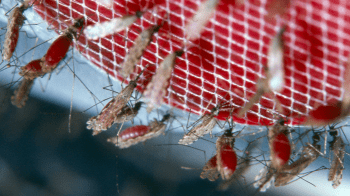
Malaria is one of the leading causes of death in the developing world, claiming nearly a million victims each year. The great majority of them are African children below the age of five. The illness is caused by a single-celled parasite called Plasmodium that is transmitted by mosquito bites to humans. In a paper published today in Nature Genetics, a group of African and British doctors and scientists report on their study of the genetic roots of malaria susceptibility. They found no new smoking gun with this effort, but learned much about how to improve African genetic studies in the future.
The researchers gathered the SNP genotypes of 2,500 children, with the consent of their parents, from a small region in The Gambia. About 1,000 of the children had been admitted to the hospital with a case of severe malaria – the other 1,500 were newborns. In a genomewide association study, the researchers checked each of a half-million SNPs (single nucleotide polymorphisms) for sharp differences in genetic composition between the group of children suffering from malaria and the group of newborns, who served as an approximation of a malaria-free group. If one version of an individual SNP was seen at high frequency among the malaria victims, but at low frequency in the newborns, then the difference might be because the SNP tends to cause malaria or is nearby one that does.
Upon scanning their data, the researchers came up more or less empty-handed: by the usual standards of the field, none of the 500,000 SNPs would pass muster.
This deflating result stands at odds with what is known already about the genetics of malaria susceptibility. Most people who have taken a biology class learn that human populations in malarial regions have developed a natural immunity to malaria infection, not through their immune systems, but through a genetic modification of hemoglobin. Hemoglobin is a molecule charged with ferrying oxygen from your lungs (and the lungs of most life forms that have them) to all your cells, an essential task. Biologists have traced hemoglobin-based malaria resistance to a change at a single DNA base pair on chromosome 11 – wouldn’t we expect at least this SNP to light up as significant?
In truth, the failure wasn’t so surprising; it arises from the interplay of genetics with our species’ history. Humans first arose in Africa, so that’s where genetic variation has had the longest time to build up. Modern-day Asian, European, and Native American people descend from people who emigrated from Africa about 50,000 years ago. These migrants carried just a subset of the African gene pool with them, so non-African populations today have much less “well-mixed” genomes than African populations. The present study uses genotyping chips developed for use in European populations, and its failure to find the known hemoglobin SNP (which isn’t even genotyped by the chip) and other known genetic contributors to malaria resistance is essentially due to the fact that you’d need more like two million SNPs than half a million to do the job right.
The solution, you’d think, is just to make a chip with a lot of markers for specific use in Africa, and be done with it. But the authors show that African genomes appear to be mixed so well that no single such chip could be designed. Instead, they propose an alternative approach: use a good but inevitably suboptimal African SNP chip in your full study sample, then obtain full genome sequences from a small number of the members of that sample. Then, using a powerful statistical method called imputation, you use the full sequences of the smaller group to fill in the full genomes of the entire study sample based on their SNP genotypes. This approach, as the authors demonstrate convincingly in the case of hemoglobin-based malaria resistance, would provide a statistically powerful and economically viable means of tracking down the causes of some of the most challenging health problems of our time.



